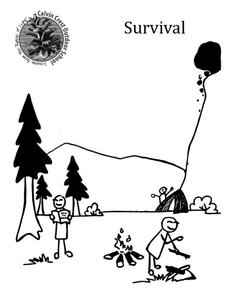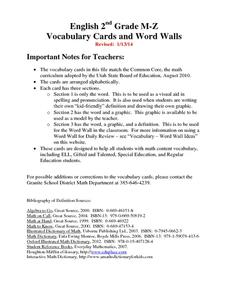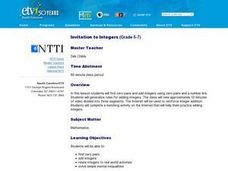Curated OER
Adding Worksheet
In this addition worksheet, students add one digit numbers up to 3 based on the book The Cat in the Hat. Students complete 10 problems.
Willow Tree
Fibonacci and Other Sequences
Fibonacci is an interesting sequence that forms some unique patterns. Learners explore sequences that do not have the typical arithmetic and geometric patterns. They identify the pattern and find the next consecutive terms....
Lynette
Prefix, Suffix, and Root Word Worksheets
Words are kind of like a train, with affixes as the added cars. Practice prefixes, suffixes, and root words with these worksheets. Learners add words on to the beginning and end of words, practice with some roots, and use the words in...
K12 Reader
Exponential Notation
Standard notation, exponential notation, base numbers and exponents are featured in an article designed to be used as a reading comprehension exercise. Kids read the passage and then respond to the comprehension questions attached to the...
Calvin Crest Outdoor School
Survival
Equip young campers with important survival knowledge with a set of engaging lessons. Teammates work together to complete three outdoor activities, which include building a shelter, starting a campfire, and finding directions in the...
Mathematics Vision Project
Module 6: Trigonometric Functions
Create trigonometric functions from circles. The first lesson of the module begins by finding coordinates along a circular path created by a Ferris Wheel. As the lessons progress, pupils graph trigonometric functions and relate them to...
Teach-nology
Understanding Singular Nouns and Plural Nouns
Primary graders practice forming the plural form of singular nouns and removing the "s" to create the singular form of plural nouns.
Federal Reserve Bank
History of Money and Banking in the U.S.
Why was there a lack of confidence in the money and banking system of the early United States government? What historical events led to the establishment of the Federal Reserve System? Here you'll find reading materials and worksheets to...
EngageNY
Mixture Problems
What percent of the mixture is juice? Pairs use their knowledge of proportions to determine what percent a mixture is juice given the percent of juice in the components. Pupils use the procedure learned with the juice mixture problem to...
Prestwick House
Vocabulary Activity Sheet
What does it mean to stream a program? How do you know if you're watching a mash-up? If you don't know these words, reach for your handy Merriam-Webster dictionary, because they're there! A series of fill-in-the-blank questions...
Curated OER
Vocabulary Cards 2nd Grade M-Z
Math vocabulary has never been easier to understand! Use vocabulary cards to bring word walls to your classroom, helping kids make the connection between important math terms and easy-to-understand illustrations.
Wild BC
Greenhouse Gas Guzzlers
Teams of six to eight players imagine that they are driving in a vehicle and collect balls that represent carbon dioxide emissions based on their different activities. "Greenhouse Gas Guzzler" cards tell teams how many balls to collect...
Curated OER
Decimal Addition
Use this guided set of equations to help scholars add double-digit numbers with decimals. They examine two examples before trying these on their own, many of which require regrouping. All of these have decimals to the hundredths place....
Curated OER
Integers - Objects Model
Sixth and seventh graders solve 19 various types of problems related to integers as objects models. They write an integer that corresponds to each letter on a number line and then, arrange the integers from least to greatest. Pupils also...
Student Handouts
What Year Is It?
This page includes a space to write in the date, but what does the date even mean? And where does it come from? Inform your class about the various calendars and how the Western calendar came into widespread use with an informational...
Scouts
The Deadly Picnic: A Lab on Deductive Reasoning
Whodunnit? Find out who killed Mr. Brooks through a logical examination of evidence. Class members fill out a couple of data tables to help them pin down the suspect. After they've figured out just who the culprit is, pupils compose...
EngageNY
Estimating Digits in a Quotient
Boiling down any division problem to a one-digit divisor problem sure makes estimation easy. The lesson shows how to estimate division problems by using place value understanding and basic arithmetic facts to simplify the division. Some...
NASA
Christa's Lost Lesson: Effervescence
How are chemical reactions affected by gravity? Learners explore the phenomenon of effervescence as part of the Christa's Lost Lessons series. They compare findings in an experiment on effervescence to a video of a similar experiment in...
GiggleUp Kids
Happy Little Farmer
Pre-readers and primaries can help farmer rabbit to plant some delicious fruits and vegetables. From soil preparation and pest control, all the way to the harvest, little ones participate in the entire process!
Curated OER
Five Minute Adding Frenzy (A)
In this five minute adding frenzy worksheet, learners problem solve four charts containing a hundred addition equations in each in less than five minutes for each one.
Curated OER
Adding or Subtraction Algebraic Fractions
In this Algebra I/Algebra II activity, students add and subtract algebraic fractions and reduce the answer to lowest terms. The two page activity contains a combination of eleven multiple choice and free response questions. ...
Curated OER
Invitation To Integers
Students find zero pairs and add integers using zero pairs and a number line. They generalize rules for adding integers. The class view approximately 10 minutes of video divided into three segments.
Curated OER
Probability- Two Events
In this statistics worksheet, students examine different events after translating the word problems into equations and choose which event is most likely to occur. There are 14 questions with an answer key.
Curated OER
The Cross Number Problem
In this algebra worksheet, students complete a cross word puzzle using numbers instead of words. Every number between 1 and 9 can only be used once. There is an answer key with this problem.























